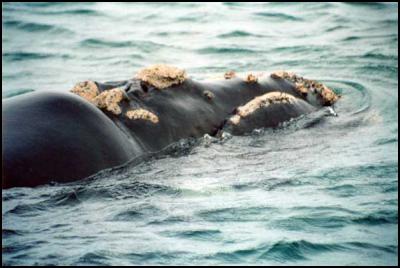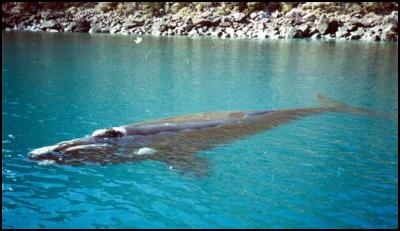Help DOC spot the right whales
Help DOC spot the right whales

Click to enlarge
Southern Right Whale. Image: Nicola Valllance

Click to enlarge
6 July 2006
Help DOC spot the right whales
The hunt is on to find out whether New Zealand has its own population of ‘homegrown’ southern right whales (tohora).
For the third year in a row, the Department of Conservation is appealing to the public for reports of sightings of southern right whales in a bid to determine whether the whales in our coastal waters are a separate population from their southern ocean relatives.
“If the mainland whales do represent a smaller separate population, we need to know about it so we can ensure that these whales are best protected from any potential impacts, such as marine farms, ship strikes and coastal development, ” said Helen McConnell, DOC marine mammal advisor.
Southern right whales have been spotted in coastal areas around Auckland – last winter off Waiheke Island and Whangapaoroa and the year before in the Kaipara Harbour. Both these sightings contributed information to the national study.
Because southern right whales spend a large portion of their winter breeding months (June – September) very close to the shore in sheltered waters, they can be easily spotted from land.
“The winter migration of the southern right whales is exciting because it provides a rare opportunity for members of the public to see large whales from the coast,” said Ms McConnell.
Reports of sightings from the public have helped DOC gain valuable information about the whales so far. In fact public sightings led to the first genetic samples being taken this year from two whales off the New Plymouth coast recently.
“In the last three years we have obtained 21 genetic samples from southern right whales around New Zealand, largely thanks to tip-offs from the public, and we’ve got many good quality photographs for individual identification as well.”
To date, none of the whales identified around the mainland have been seen in areas further a field. This supports the theory that they may indeed be geographically isolated from other populations, but more data is necessary in order to confirm this theory.
Regardless of the findings of the study, Ms McConnell is of the opinion that we should be celebrating the return of these majestic creatures to our coasts after they all but disappeared following intensive commercial whaling last century.
Southern right whale sightings should be reported to DOC, preferably as soon as possible after the sighting is made, on 0800 DOCHOT line (0800 36 24 68). DOC needs to know the date, time and location of the sighting; the number of whales; whether there were any calves; and their direction of travel.
Photos help identify individual whales, especially those of the left side of the head, and of the full body length.
--
Background
Right whales were so-called because they were the “right” whales to kill - large, slow-moving beasts that obligingly floated when dead and yielded large amounts of valuable oil, bone and baleen.
Once thought to number 16,000 in New Zealand waters, including the sub-Antarctic, they had all but disappeared by 1860 because of whaling pressure. In one winter season, in 1836, at least 97 whales were killed by crews from three whaling ships in Lyttelton Harbour alone.
Adults are on average 14.5m long, and newborn calves, between 4.5m and 6m. They are mostly black in colour and can be identified by their lack of a dorsal fin, a V-shaped blowhole spray, and white growths on their heads called callosities. Each whale has a unique callosity pattern.
Whales should be approached slowly, quietly and cautiously, and no closer than 50m, preferably from behind or parallel to them. Boaties are requested not to obstruct their path, cut through a group or separate mothers from calves, and to cut their engines if a whale approaches their vessel. Making sudden noises may startle the animals and should be avoided. Aircraft should keep a 150 m distance from whales and not fly directly over them.
ENDS


 Bill Bennett: Download Weekly - 100% claim lands One New Zealand in criminal court action
Bill Bennett: Download Weekly - 100% claim lands One New Zealand in criminal court action FSCL: Woman Scammed Out Of $25,000 After Job Offer On LinkedIn
FSCL: Woman Scammed Out Of $25,000 After Job Offer On LinkedIn NIWA: Cheers To Crustaceans - New Species Named After Welly Brewery
NIWA: Cheers To Crustaceans - New Species Named After Welly Brewery MBIE: Trans-Tasman Earth Observation Research Studies Confirmed
MBIE: Trans-Tasman Earth Observation Research Studies Confirmed NZ Association of Scientists: Royal Society Te Apārangi Governance Submissions Close - NZAS Submission
NZ Association of Scientists: Royal Society Te Apārangi Governance Submissions Close - NZAS Submission HortPlus: Project Aims To Improve Quality Of Weather Data In New Zealand
HortPlus: Project Aims To Improve Quality Of Weather Data In New Zealand



